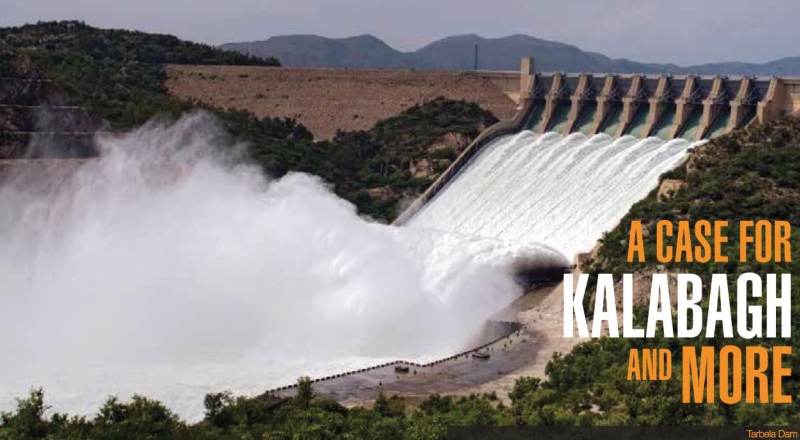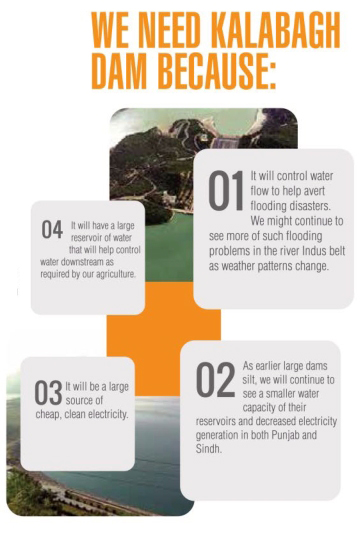As Pakistan battles the fierce waves of its great rivers, experts argue that the destruction caused by the floods could have been prevented if we had invested more in building large dams on our river system, especially the Indus River. We believe that multipurpose dams and new reservoirs are crucial, given the country’s looming water and energy crises, against a backdrop of rapid urbanization, population growth, food insecurity and a growing water demand from the industrial sector.

Tarbela Dam
Pakistan Council of Research in Water Resources (PCRWR) estimated our population at 187 million with an annual growth rate of 1.57 percent. By the year 2050, the population is expected to double and would become 63.7% urban as compared to only 36% in 2010. Out of the 140 million acre feet (MAF) of water annually available in Pakistan in a normal year, only about 40 MAF reaches the Indus delta. The Indus basin irrigates about 14 million hectares of land in Pakistan – the largest irrigated area in the world – for which a huge amount of water is needed. With only two existing major reservoirs in the Indus basin – the Mangla and Tarbela – the storage capacity of Pakistan is only about 30 days, while most of the developed countries have a 1 – 2 year water storage capability. Considering that 21 percent of our economy is based on agriculture, problems of food shortage, high inflation and irrigation water scarcity are critical. Energy crisis is another pertinent issue in the country, linked directly with high inflation.

Why we need the Kalabagh Dam
This is where the Kalabagh dam comes into the picture. Conceived in 1953, it was initially planned out to be a water storage structure, until 1973 to 1984 when the design was changed to make it a multi-purpose large dam. As advocated of this project, we would like to highlight its importance. We are not only facing a severe electricity shortage, but despite possessing the best irrigation system, we still import wheat on credit. The Kalabagh dam is expected to produce 3600 additional megawatts of electricity. The per unit cost will come to as low as two rupees where thermal power costs Rs. 16 per unit. This additional electricity will also reduce the dependency on imported fuels. It is estimated that with the large water reservoir, the irrigation needs of all the four provinces will be reasonably met. Furthermore, it is a vital instrument in the prevention of floods and in preventing the devestation we have seen in recent years in KPK, Central and Southern Punjab and Sindh. The direct benefits after the dam will be functional will amount to Rs. 25 billion per annum. This way the investment cost will be covered within a period of 9 – 10 years. Another incentive is the creation of employment opportunities for 30,000 individuals during the construction and significant numbers after commissioning.
– TEAM OF ENGINEERS
AM, AA, GQ @ Landscape
FIRST PUBLISHED IN THE LANDSCAPE NEWSLETTER (NOVEMBER, 2017)
 Tarbela Dam
Pakistan Council of Research in Water Resources (PCRWR) estimated our population at 187 million with an annual growth rate of 1.57 percent. By the year 2050, the population is expected to double and would become 63.7% urban as compared to only 36% in 2010. Out of the 140 million acre feet (MAF) of water annually available in Pakistan in a normal year, only about 40 MAF reaches the Indus delta. The Indus basin irrigates about 14 million hectares of land in Pakistan – the largest irrigated area in the world – for which a huge amount of water is needed. With only two existing major reservoirs in the Indus basin – the Mangla and Tarbela – the storage capacity of Pakistan is only about 30 days, while most of the developed countries have a 1 – 2 year water storage capability. Considering that 21 percent of our economy is based on agriculture, problems of food shortage, high inflation and irrigation water scarcity are critical. Energy crisis is another pertinent issue in the country, linked directly with high inflation.
Tarbela Dam
Pakistan Council of Research in Water Resources (PCRWR) estimated our population at 187 million with an annual growth rate of 1.57 percent. By the year 2050, the population is expected to double and would become 63.7% urban as compared to only 36% in 2010. Out of the 140 million acre feet (MAF) of water annually available in Pakistan in a normal year, only about 40 MAF reaches the Indus delta. The Indus basin irrigates about 14 million hectares of land in Pakistan – the largest irrigated area in the world – for which a huge amount of water is needed. With only two existing major reservoirs in the Indus basin – the Mangla and Tarbela – the storage capacity of Pakistan is only about 30 days, while most of the developed countries have a 1 – 2 year water storage capability. Considering that 21 percent of our economy is based on agriculture, problems of food shortage, high inflation and irrigation water scarcity are critical. Energy crisis is another pertinent issue in the country, linked directly with high inflation.
 Why we need the Kalabagh Dam
This is where the Kalabagh dam comes into the picture. Conceived in 1953, it was initially planned out to be a water storage structure, until 1973 to 1984 when the design was changed to make it a multi-purpose large dam. As advocated of this project, we would like to highlight its importance. We are not only facing a severe electricity shortage, but despite possessing the best irrigation system, we still import wheat on credit. The Kalabagh dam is expected to produce 3600 additional megawatts of electricity. The per unit cost will come to as low as two rupees where thermal power costs Rs. 16 per unit. This additional electricity will also reduce the dependency on imported fuels. It is estimated that with the large water reservoir, the irrigation needs of all the four provinces will be reasonably met. Furthermore, it is a vital instrument in the prevention of floods and in preventing the devestation we have seen in recent years in KPK, Central and Southern Punjab and Sindh. The direct benefits after the dam will be functional will amount to Rs. 25 billion per annum. This way the investment cost will be covered within a period of 9 – 10 years. Another incentive is the creation of employment opportunities for 30,000 individuals during the construction and significant numbers after commissioning.
– TEAM OF ENGINEERS
AM, AA, GQ @ Landscape
FIRST PUBLISHED IN THE LANDSCAPE NEWSLETTER (NOVEMBER, 2017)
Why we need the Kalabagh Dam
This is where the Kalabagh dam comes into the picture. Conceived in 1953, it was initially planned out to be a water storage structure, until 1973 to 1984 when the design was changed to make it a multi-purpose large dam. As advocated of this project, we would like to highlight its importance. We are not only facing a severe electricity shortage, but despite possessing the best irrigation system, we still import wheat on credit. The Kalabagh dam is expected to produce 3600 additional megawatts of electricity. The per unit cost will come to as low as two rupees where thermal power costs Rs. 16 per unit. This additional electricity will also reduce the dependency on imported fuels. It is estimated that with the large water reservoir, the irrigation needs of all the four provinces will be reasonably met. Furthermore, it is a vital instrument in the prevention of floods and in preventing the devestation we have seen in recent years in KPK, Central and Southern Punjab and Sindh. The direct benefits after the dam will be functional will amount to Rs. 25 billion per annum. This way the investment cost will be covered within a period of 9 – 10 years. Another incentive is the creation of employment opportunities for 30,000 individuals during the construction and significant numbers after commissioning.
– TEAM OF ENGINEERS
AM, AA, GQ @ Landscape
FIRST PUBLISHED IN THE LANDSCAPE NEWSLETTER (NOVEMBER, 2017)

